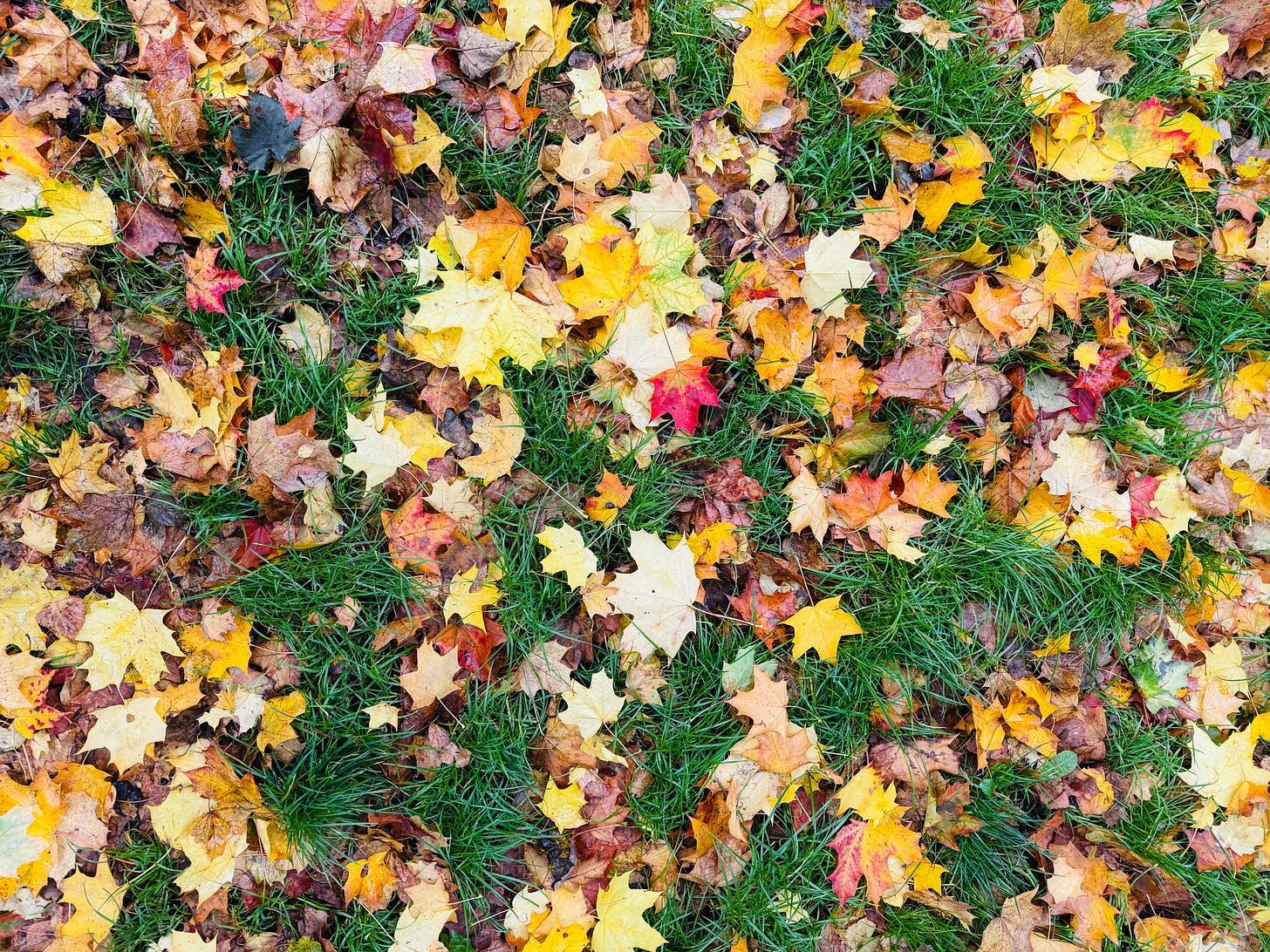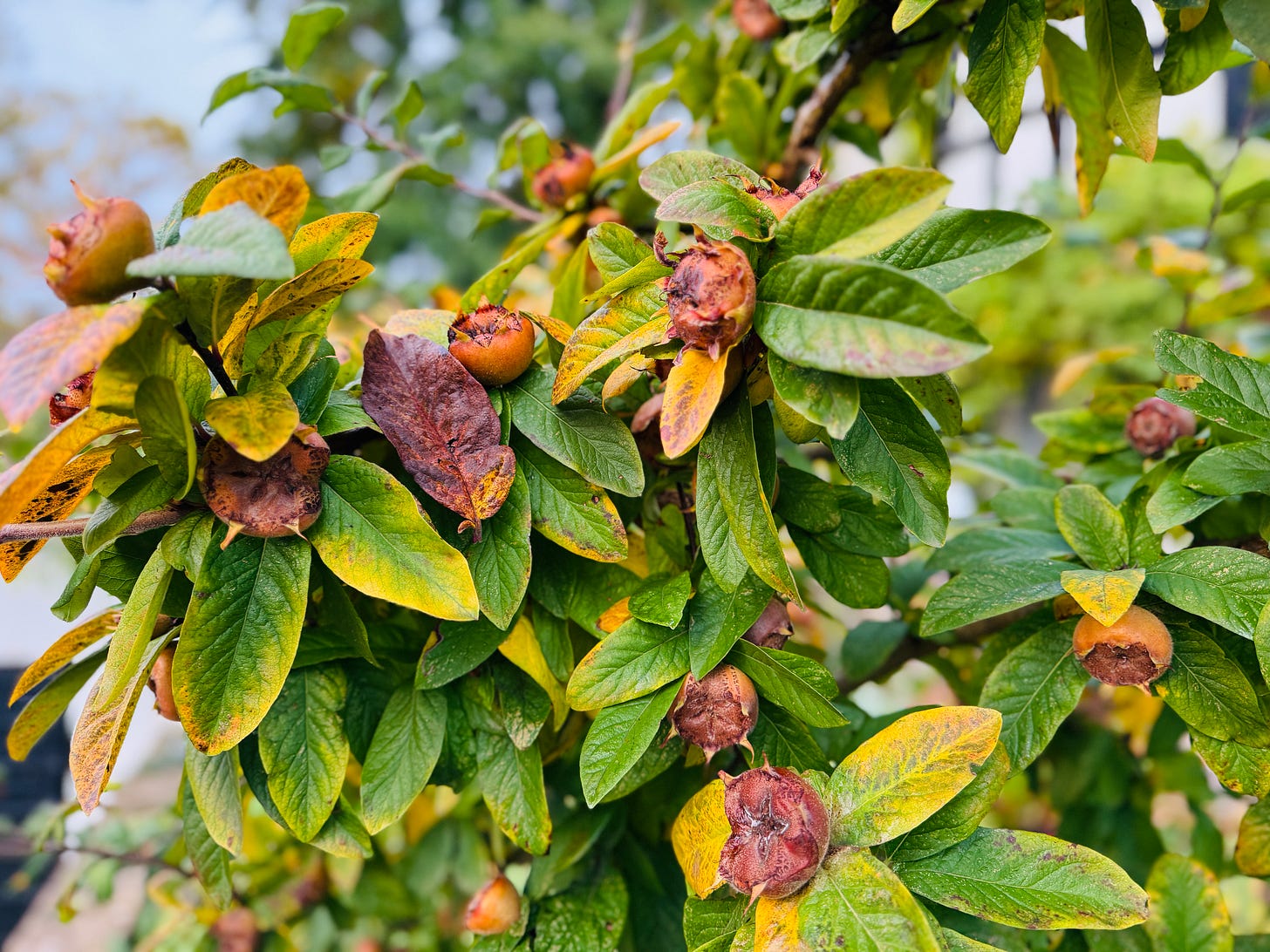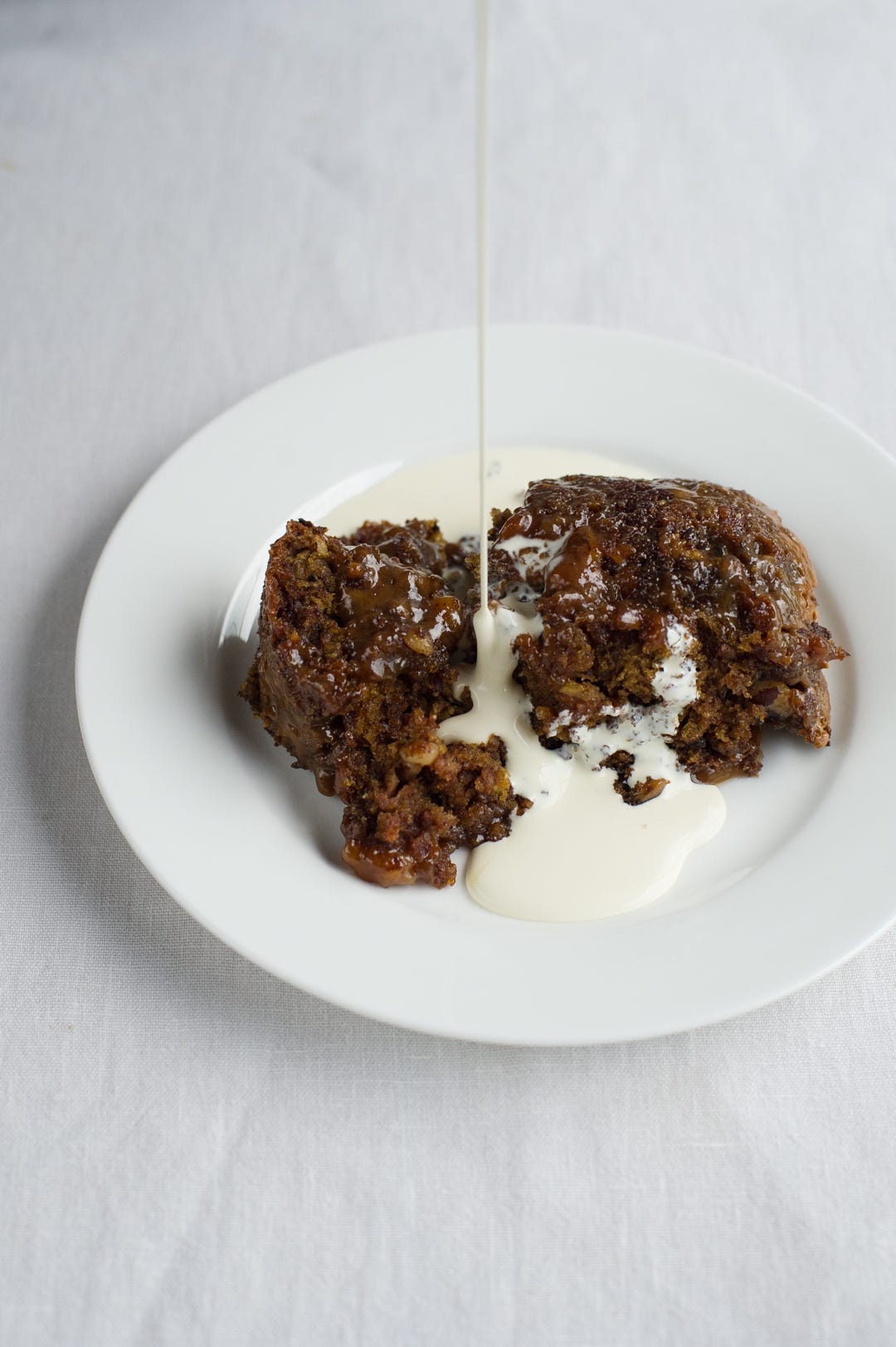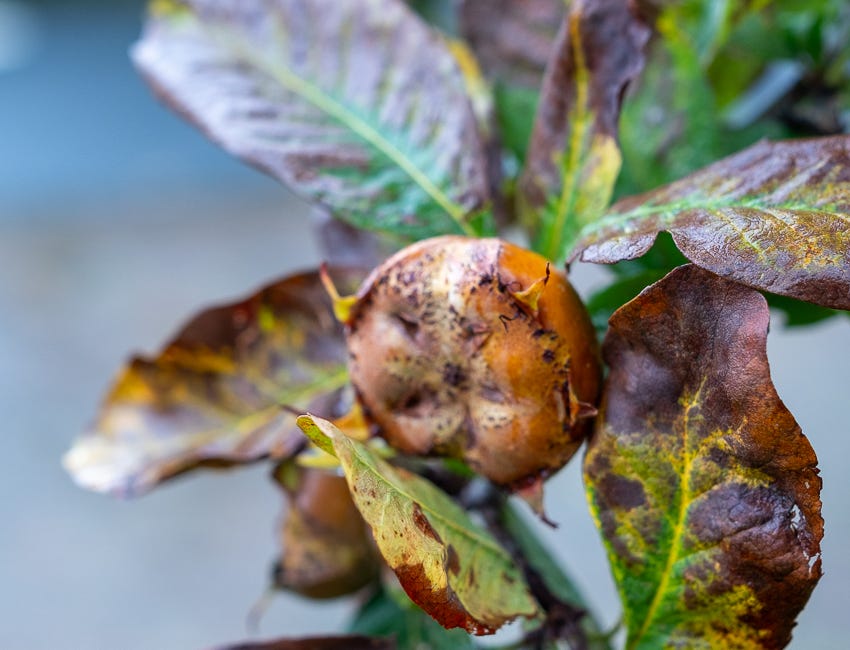Medlars, UHT, river basins and three excellent recipes
Abundance; Saturday 25 October 2025
Well, it seems the French are still a bit shit at coffee if my few days in Paris is anything to go by. Hello wrong type of coffee beans, and WTF UHT. Howsomeever, the mighty swing to the caffeine roundabout (as I was reminded on my return to the UK) comes in the French not mithering rail travellers with endless noise pollution in the form of seeing, saying, scraping your own pancreas out with the plastic coffee lid left by the previous occupant of your seat.
Despite the rail announcements, it’s good to be home.
I’ve been thinking of medlars. Even while in Umbria and Paris last week, the small tree in our garden - 1150 miles away as the car drives - popped into my mind now and again. And today, after a fortnight of wondering whether it is still carrying its fruit, I’m relieved to find all but 6 medlars remain attached to their mother1 , with most approaching their perfect point of ripeness.
If ever a tree - with it beautiful irregularity, the flavour of its deep winey fruit, and its turning leaves resembling river basins seen from space - sang of autumn, it is the medlar.
Beautiful as trees and delicious in the eating, I’m also attached to medlars because of a famous2 victory. As any middled aged man will tell you, tiny wins witnessed by almost no-one is all we have left. I claim excellence in only two arenas - the pool table and the Scrabble board - and, knowing this, a friend challenged me, using his son as his knight, to a Scrabble match. I was being soundly thrashed by his genius offspring until the final go of the game where I managed to place BLETTING (see below) with enough triple letter and triple word embellishments to win by the narrowest of margins and retain my status as Scrabble champion. Without it, who knows where I’d be.
Anyway…where was I…medlars. If you aren’t familiar with them, this film might help: a trip to Totnes3 a few weeks ago threw up something special; an avenue of medlars in the churchyard that revealed itself during a backstreet explore. With luck, some of the fruit will still be on those trees, so if you can make it to Totnes, pick a few while leaving plenty for others.
For the most part, medlars aren’t eaten when hard as a conker, they are allowed to blet. Bletting (from the French ‘blettir’ - to make soft) is a process of gentle decay that takes some fruit - such as medlars and sorbs - from hard and unappetising to a sweeter, creamy delight.
Clinging to the tree even when the leaves have coloured with autumn and dropped, medlars need a good hard frost or two for the cell walls to buckle and bletting to begin. The firm pale flesh softens incrementally to a deep brown pulp. This can happen without frosts, over a good long season, as it happening right now in the UK.
So what do you do with medlars, you may ask.
My default is to half them and cook on the laziest of simmers in enough water to reach halfway up the medlar halves. When they have surrendered to a soft buttery pulp, push through a sieve/mouli to separate the seeds and any undissolved skin (discard both) from the pulp. Freeze in 200g batches for the sticky toffee pudding below, and other desserts.
Secondly, you have to make medlar jelly - it really is the prince of jellies. The recipe is below, too.
For something altogether quicker, bake a few bletted medlars in a moderate oven for 15 minutes, spoon out the soft pulp (discarding the 5 large seeds) and try it with a little honey and cream (or with blue cheese) and a glass of Tokaji or other sweet white wine. Or a smoky Islay whisky. A wintery fireside treat if ever there was one.
And where might you get fruit from should there not be a tree in your garden and you not be near Totnes?
The answer is from
. Jane planted 115 trees, now the national collection of medlars, in her corner of East Anglia, known as Eastgate Larder. She has a minimum order of 5kg, but that gives you plenty to make sticky toffee pudding, freeze pulp for more later, make jelly and have a play. And you’ll be contributing to an unique edible landscape, where the trees grow entirely naturally on ground that is fed with Jane’s mix of homemade compost, leaf mould and wood chip, and where the picking and packing is done by her. A forgotten fruit, very much back to life. And you could do far worse than get her excellent book about the history, growing and cooking of the medlar (with numerous other recipes) at the same time. All from the Eastgate Larder website.For smaller quantities, you might still get lucky at Hodmedod’s online shop before the bletting takes over and they get too soft to send.
And so below, three actual recipes, for your pleasure. I’m off in the vain hope my wife will agree to a fireside game of Scrabble.
Happy autumn to you.
Medlar jelly
Use a mixture of bletted and unbletted medlars here, or fruit that is only half way soft, as the unbletted portion has more pectin and ensures your jelly will set more easily.
Makes 4 x 225g jars, ish
500g unbletted medlars
500g bletted medlars
Juice of ½ lemon
About 500g granulated sugar
1 vanilla pod
Cut the medlars in half, put them in a large pan and pour in just enough water to cover. Add the lemon juice, bring the water to the boil, lower the temperature and simmer gently for an hour. Don’t mash the fruit, as this will make your jelly cloudy.
When the fruit is soft, strain overnight through a jelly bag into a bowl4.
Put a couple of saucers into the freezer. Measure the juice and pour it into a clean pan (you can use the discarded pulp to make the chutney).
For each 500ml of juice, add 375g of granulated sugar. Add the vanilla pod, split along its length, and warm gently, stirring, until the sugar has dissolved. Turn up the heat and boil, without stirring, for 5 minutes or so. Test the jelly for the setting point by dribbling a little onto a chilled saucer, leaving it for a minute and then pushing it with your finger – if it wrinkles, it’s done.
Allow another 5 minutes boiling if the setting point hasn’t been reached and test again. Repeat if necessary. Pour while still warm into sterilised jars and seal. The jelly will keep, sealed, in a cool, dark place for 12 months.
Medlar sticky toffee pudding
Medlars make excellent jams and jellies but a Twitter chat with Xanthe Clay many years ago led me down the experimental road to creating this fine dessert. I made it for my father in law once - a man given to old school puds but most certainly not to effusive praise - and I thought for a moment he might shed a tear. If there was a reason I was brought to this planet, this may be it.
The brief grilling at the end is by no means essential, but it turns the top beautifully fudgy.
The best way to deal with medlars is to half them and cook on the laziest of simmers along with enough water to reach halfway up the height of the sea of medlars. When they have surrendered to a soft buttery pulp, push through a sieve/mouli to sieve out the seeds and any undissolved skin. Freeze in 200g batches for this and other desserts.
Serves 6
For the sauce:
125g unsalted butter
70g golden caster sugar
50g dark muscovado sugar
150ml double cream
For the cake:
200g medlar pulp
60g unsalted butter, softened
85g golden caster sugar
70g dark muscovado sugar
2 eggs
1 tsp bicarbonate of soda
180g plain flour
1 tsp baking powder
1 tsp ground cloves
1/2 tsp salt
85g walnuts, crushed
Preheat the oven to 180°C.
Lightly butter a baking dish approximately 24cm x 20cm.
Put the sauce ingredients in a pan, and heat gently until the butter melts. Turn the heat up and boil for 5 minutes, stirring frequently, until the sauce coats the back of a spoon. Pour a little over half of the sauce into the dish, allow to cool and refrigerate to firm up the sauce.
Beat the butter and sugars together, then add in the eggs, one and a time and beat until combined. Stir in the flour, baking powder, bicarbonate of soda, cloves and salt until incorporated. Thoroughly stir in the medlar pulp and the walnuts.
Spoon the mixture into the dish, over the toffee sauce. Bake for 30 minutes.
Turn the grill on to a moderate heat. Make holes in the cake with a knife - just large enough to allow the sauce to soak in to the sponge - and pour over the remaining sauce. Grill for just long enough to crisp the top a little. Serve with a great deal of double cream or vanilla ice cream.
Medlar thing
I wrote this a couple of years ago, and it includes a medlar recipe you might enjoy.
Medlars, Barbra Streisand, Airfix and two sheriff's badges
It’s the first morning that the air - rather than the wind - bites cold. The sky is the blue I’d paint the underside of the old man’s Airfix planes when he trusted me to; the sea - lapping softer than it has for a fortnight - straight out of The Way We Were
And, given they’re self fertile, father
The definition of poetic licence
I did not see the Totnes monster
In the absence of a jelly bag and stand, turn a chair onto a table so that the seat is flat on the tabletop. Tie knots into each corner of a large square of muslin, so that it hangs from the legs of the upturned chair and place the bowl between the legs. Pour the fruit into the muslin and, as before, leave to strain into the bowl below. Give it a go, you’ll see what I mean.









Ha!
Jane Steward of Eastgate Larder here.
Mark, such a wonderful love letter to the marvellous, and still mysterious medlar. Your lyrical writing makes me fall in love with them all of again. (And I’m still looking for my own ‘bletting’ triumph on the Scrabble board!!!)
Thank you for highlighting my own medlar activities, fruit, and the book too.
I’m sure your readers are also familiar with Hodmedod’s, fabulous champions of Slow Food, beans, pulses and grains based here in East Anglia. They are adding unbletted medlars to their online shop from next week, for as long as they are still in their ‘conker’ state. Which may not be for long, as all my trees are already sporting bletted, dark sweet and and soft medlar fruit alongside their golden orbs of conkerness.
The Hodmedod’s setup means they are able to supply much smaller quantities to retail customers, as little as 1kg. Which is much harder for me.
Of course, nothing beats picking your own. And this year, the medlars are as abundant as their blossoms were in May.
Happy sourcing everyone, may your bletting be easy, and don’t forget to eat some as a fresh fruit with some cheese or charcuterie. An unbeatable, if slightly sticky experience!!
Best wishes
Jane
My computer is running out of juice, I am meant to be finishing something and got caught in your wonderful words. They are mulled and bletted and make Saturday selling cheese at a farmers market possible. I can talk to everyone about getting a medler mother and to use a chair and muslim to make the best jelly to go with their West Country Saint Marcellin. Happiness.